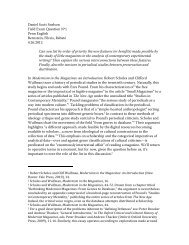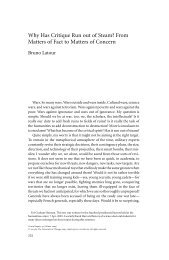The Exploit: A Theory of Networks - asounder
The Exploit: A Theory of Networks - asounder
The Exploit: A Theory of Networks - asounder
Create successful ePaper yourself
Turn your PDF publications into a flip-book with our unique Google optimized e-Paper software.
Nodes 99<br />
guarded condition, it will be sculpted anew into something better,<br />
something in closer agreement with the real wants and desires <strong>of</strong> its<br />
users.<br />
<strong>The</strong> third point has to do with structure. Because networks are (technically)<br />
predicated on creating possible communications between nodes, oppositional<br />
practices will have to focus less on the characteristics <strong>of</strong> the nodes<br />
and more on the quality <strong>of</strong> the interactions between nodes.<br />
In this sense, the distinction between node and edge will break<br />
down. Nodes will be constructed as a by - product <strong>of</strong> the creation <strong>of</strong><br />
edges, and edges will be a precondition for the inclusion <strong>of</strong> nodes in<br />
the network. Conveyances are key. From the oppositional perspective,<br />
nodes are nothing but dilated or relaxed edges, while edges are constricted,<br />
hyperkinetic nodes. Nodes may be composed <strong>of</strong> clustering<br />
edges, while edges may be extended nodes.<br />
Using various protocols as their operational standards, networks tend to<br />
combine large masses <strong>of</strong> different elements under a single umbrella. <strong>The</strong><br />
fourth point we <strong>of</strong>fer, then, deals with motion: counterprotocol practices<br />
can capitalize on the homogeneity found in networks to resonate far and<br />
wide with little effort.<br />
Again, the point is not to do away with standards or the process <strong>of</strong><br />
standardization altogether, for there is no imaginary zone <strong>of</strong> nonstandardization,<br />
no zero place where there is a ghostly, pure flow <strong>of</strong> only<br />
edges. Protocological control works through inherent tensions, and<br />
as such, counterprotocol practices can be understood as tactical implementations<br />
and intensifications <strong>of</strong> protocological control.<br />
On a reflective note, we must also acknowledge that networks,<br />
protocols, and control are not only our objects <strong>of</strong> study; they also<br />
affect the means and methods by which we perform analysis and critique.<br />
Events such as computer viruses or emerging infectious diseases<br />
require a means <strong>of</strong> understanding that draws together a number <strong>of</strong><br />
disciplines, modes <strong>of</strong> analysis, and practices. This challenge bears as<br />
much on cultural theory and the humanities as it does on computer<br />
science, molecular biology, and political theory.









